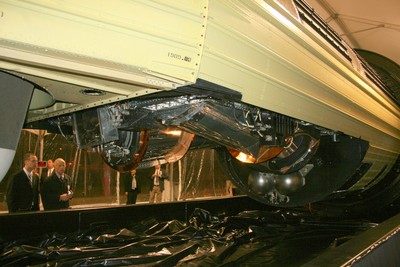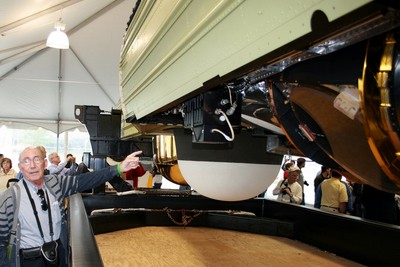Working in the shadows: Phil Pressel and the Hexagon spy cameraby Roger Guillemette and Dwayne Day
|
| Tears welling in his eyes, the Belgian boy who was hidden from the Nazis by the French Resistance in a picturesque mountain town took his wife’s hand and humbly pointed to the Hexagon’s engineering marvel: twin panoramic rotating cameras. |
On September 17, 2011, the then 74-year-old Holocaust survivor and kidney transplant recipient patiently waited in line with his wife as the doors opened to a large tent structure at the Smithsonian National Air & Space Museum’s Udvar-Hazy Center. His life-long secret, an integral component in one of the United States’ most closely guarded assets, a behemoth larger than a school bus, was now on display for the whole world to see: the just-declassified KH-9 Hexagon spy satellite.
Tears welling in his eyes, the Belgian boy who was hidden from the Nazis by the French Resistance in a picturesque mountain town—a story that he recounted in a 2004 book—took his wife’s hand and humbly pointed to the Hexagon’s engineering marvel: twin panoramic rotating cameras that exposed the former Soviet Union’s hidden missile bases, bomber airfields and submarine holding pens.
Incorporated into the belly of the giant spacecraft was the “optical bar” camera system that produced incredibly valuable intelligence data for his adopted country, detailed imagery that helped prevent a cataclysmic World War III between the global superpowers. Phil Pressel and his colleagues designed the cameras.
Pressel has now published a book about developing the Hexagon camera, Meeting The Challenge: The Hexagon KH-9 Reconnaissance Satellite. It is a detailed, behind-the-scenes account of designing the most complex mechanical device ever flown in space, and one of the most powerful reconnaissance cameras ever built. Pressel, after getting permission from the CIA to write the book and agreeing not to have it published until after declassification of the program, started the book years before the program was declassified, not knowing if he would ever be allowed to publish it (see “Eyes of the Big Bird”, The Space Review, October 14, 2013.)
“I teared up when I first saw the Hexagon on display. Then I saw my optical bars (cameras). I was responsible for the design of the cameras. There were many, many other important subassemblies designed by others. It was overwhelming,” said Pressel. “This is still the most complicated system we’ve ever put into orbit… Period.” Decades after the last Hexagon flew, Pressel realized that he wanted to “tell the story of Hexagon to tell the world what we did and to honor the people who worked on it and our company Perkin-Elmer.” That wasn’t possible until now. “I lived with secrecy at Perkin-Elmer for 30 years. We were never allowed to talk about anything.”
“We couldn’t use the word ‘film’, we could never use ‘Hexagon,’ we couldn’t say ‘optical bar’ and other words,” he recalled. “We used abbreviations and we had to talk in code.”
That shroud of secrecy even extended to his wife. “I never knew what Phil was working on, nor did I ask,” confided Pat Pressel. “It was just part of our daily existence. He would come home from work, I’d ask ‘How was your day at the office?’ and that was it. Even on his business trips, the only thing I knew was what city he was in.”
Pressel was hired by the Connecticut-based instrumentation manufacturer Perkin-Elmer in 1965 to work on a “special projec” for the government. He soon realized that this would be no ordinary engineering job.
“I and a few others worked on the design study for the Hexagon program for almost two years. We had various concepts, various systems and we finally settled on a design in the spring of 1966,” recalled Pressel. “We were competing against Itek Corporation [manufacturer of the camera in the first US photo-reconnaissance satellite program, Corona.] Finally, on October 10, 1966, our vice-president gathered the 30 of us who worked on the study and proposal, lit a cigar and informed us that we had won the Hexagon contract.”
Meeting the Challenge tells the story of how Perkin-Elmer bid on the proposal, designed the complex camera, integrated it into the spacecraft, and then put it into operation. Eventually over 1000 people worked on the program. The book also contains stories and anecdotes about people and events.
 A view of part of the Hexagon camera system. (credit: R. Guillemette) |
In his book, Pressel recounts how he and his colleagues in Perkin-Elmer’s “war room” monitored the launch of the first KH-9 Hexagon on June 15, 1971, from California’s Vandenberg Air Force Base, listening in to an audio loop account of the rocket’s ascent. Because of classification restrictions, only a few Perkin-Elmer personnel were allowed to go to the launch site.
| “We couldn’t use the word ‘film’, we could never use ‘Hexagon,’ we couldn’t say ‘optical bar’ and other words,” he recalled. “We used abbreviations and we had to talk in code.” |
Seasoned launch teams at Vandenberg were astounded by the sheer size of the Titan III-D launch vehicle and its massive secret payload. The media nicknamed the Hexagon satellite “Big Bird,” and that moniker was then used regularly in magazine and newspaper articles about this American reconnaissance satellite program. None of the articles came remotely close to describing the actual spacecraft.
After achieving orbit, the KH-9 Hexagon was commanded to begin its on-orbit check-out and calibration procedures, and Phil Pressel’s twin “optical bar” panoramic cameras began rotating, sweeping the Earth as the satellite flew in a polar orbit over the Earth that was rotating from west to east below it. This was a process that intelligence officials referred to as “mowing the lawn.”
The Hexagon was a “search” system designed to cover the entire landmass of the earth and designed to capture specific targets such as military construction projects, missile base sites, repositioning of troops and materiel, radar installations and activity at submarine bases and airfields, all in stereo. Each sweep of the camera photographed a wide swath of terrain covering up to 370 nautical miles (685 kilometers)—the distance from Cincinnati to Washington—on every orbital pass over the former Soviet Union and China or to cover smaller specific areas of interest.
One of the rotating cameras looked forward of the satellite while the other looked aft, thus capturing detailed imagery in stereo, with a resolution of about 2 to 3 feet (0.6 to 0.9 meters), according to the National Reconnaissance Office (NRO).
“The whole camera system operated in a vacuum, except for the film, which was in a pressurized container and film path in order to prevent loss of humidity in the film,” explained Pressel. “The most remarkable thing was the amazing speed at which the film traveled through the camera systems and the manner it passed by the camera’s focal plane.”
One major aspect of Pressel’s book is his description of the film transporter’s unique “twister” system as well as the film’s modest speed as it wound through the cameras, over many dozens of rollers, compared to its astounding speed—200 inches per second (500 centimeters per second) at the camera’s focal plane—as the film was riding on a film of air on the twister near the focal plane. The “twister” allowed the film to travel both linearly and in rotation synchronizated with the rotating image in the optical bars. This innovative “air bar twister” technique and the use of a film storage device called the “looper” made maximum use of the 60 miles (97 kilometers)—30 miles of film for each camera—of 6.6-inch (16.8-centimeter) wide, high resolution Kodak film packed into the 60-foot-long (18.3-meter-long) KH-9 Hexagon spacecraft.
| “The Hexagon was so complicated that many of us had doubts that it would actually work. And, when it did work, we were simply amazed… it worked magnificently.” |
Once the on-orbit check-out was completed, the system became operational and took photographs as required by the intelligence community. Once the first re-entry take-up reels were filled in the first of Hexagon’s four reentry vehicles, the film “bucket” was released and plunged through the Earth’s atmosphere. A specially modified C-130 aircraft would catch the return capsule in mid-air by snagging its parachute following the canister’s re-entry. The precious cargo was immediately flown back to the mainland, its film processed and, within days, analysts began scrutinizing the high-resolution images recorded by Pressel’s panoramic cameras.
“When we first saw some of the first photographs taken of the United States, I was so very, very proud,” exclaimed Pressel. “It was ‘Wow!’ The Hexagon was so complicated that many of us had doubts that it would actually work. And, when it did work, we were simply amazed… it worked magnificently.”
His and his colleagues’ lifetime’s secret work is now on display at the National Museum of the US Air Force in Dayton, Ohio, which eventually plans to suspend it from the ceiling as if it is flying overhead.
Pressel explained his motivation to work on the Hexagon. “I never wanted to work on an offensive weapon system, something that would kill people. I am happy that I always worked on reconnaissance or intelligence projects, projects that secured our country.”
